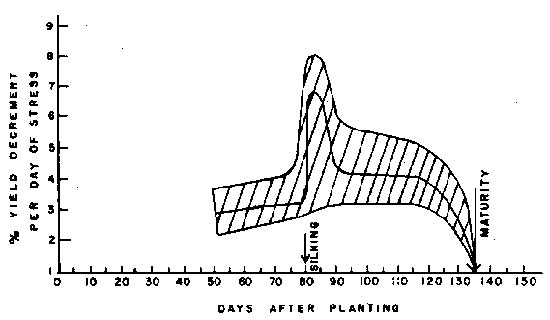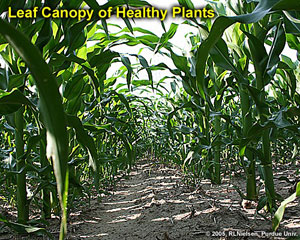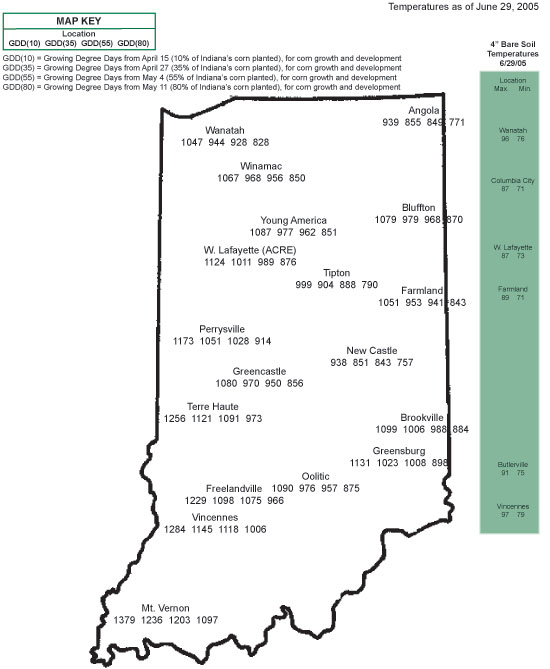Pest & Crop Newsletter, Entomology Extension, Purdue University
European Corn Borer Damage Showing Up – (John Obermeyer, Christian Krupke, and Larry Bledsoe)
- Moth flights have been low this year, but some economic damage being found.
- Steps to determine treatment threshold given below.
- List of recommended insecticides available online.
Black light counts and reports of windshield splatters of European corn borer moths have been low. The state’s overall corn borer population this year seems to be unimpressive. However, significant whorl damage has been found by some pest managers, with a few fields at treatable levels. With the exception of B.t. corn that offers corn borer protection, all corn in the whorl stage should be scouted soon - before larvae bore into the stalks, making them impossible to control.

Shot hold damage in corn whorl.
To scout for corn borer damage, survey for the characteristic random or “shot hole” damage pattern down in the corn whorl of 20 consecutive plants in each of 5 areas of the field. Carefully examine the whorl leaves on each plant, as some of the holes can be small. Count and record the number of plants showing foliar feeding damage. Total the number of plants showing such damage to determine the percentage of damaged plants. It is also important to determine if borers are still present and actively feeding. To do this, pull out, carefully unroll, and examine the whorl leaves from one plant showing damage in each sample set, with a maximum of 5 plants in the entire field. Total the number of live borers found and determine the average number of borers/plant.
| Yield Losses Caused by European Corn Borers for Various Corn Growth Stages 1 | |||
| Plant stage | Percent yield loss- #borers/plant 2 |
||
1 |
2 |
3 |
|
| Early whorl | 5.5 |
8.2 |
10.0 |
| Late whorl | 4.4 |
6.6 |
8.1 |
| Pre-tassel | 6.6 |
9.9 |
12.1 |
| Pollen shedding | 4.4 |
6.6 |
8.1 |
| Blister | 3.0 |
4.5 |
5.5 |
| Dough | 2.0 |
3.0 |
3.7 |
|
|||
Use the following steps to determine whether an insecticide treatment is economically justified:
- Preventable yield loss (bu/A) = anticipated yield (bu/A) X yield loss figure (following table) X level of infestation (decimal) X anticipated level of control (decimal). Note that it is impractical to expect 100% control. A good estimate of control might be 75%.
- Preventable dollar loss/A = Preventable yield loss (bu/A) X market value ($/bu).
- Compare preventable dollar loss/A to cost of insecticide and application to determine if treatment is warranted.
For recommended insecticides, see E-219, Corn Insect Control Recommendations – 2005. This and other field crop related publications can be viewed electronically at http://extension.entm.purdue.edu/eseries3/.
![]()
Leafhopper Populations Booming - (John Obermeyer, Christian Krupke, and Larry Bledsoe)
- Regrowth is most at risk to feeding damage.
- Damage has already occurred once "hopper burn" is noticed.

Close-up of a potato leafhopper.
Populations of potato leafhopper in alfalfa fields have been rising throughout the state. There have been observations of high numbers of leafhoppers coming to lights at night. Undoubtedly, the hot and dry conditions have contributed to this population explosion.
Producers are encouraged to inspect new growth soon after cutting for potato leafhopper; this is when alfalfa is most susceptible to feeding, leading to reduced yields and protein levels. Remember, once yellowing or “hopper burn” is seen, the damage has already been done. Refer to Pest&Crop #10, for sampling and management guidelines. For recommended insecticides, see E-220, Alfalfa Insect Control Recommendations – 2005. This and other field crop related publications can be viewed electronically at www.entm.purdue.edu/entomology/ext/targets/e-series/fieldcro.htm.
![]()
Japanese and Rootworm Beetles Emerging - (John Obermeyer, Christian Krupke, and Larry Bledsoe)
- Japanese beetle have been emergin for over a week.
- Western corn rootworm beetles beginning to emerge.
- Beetles should not be a concern until fields are polinating.
- Isolated, late-pollinating fields could be a "trap crop" for beetles.
Another season featuring the beetles we love to hate has begun throughout the state, as emergence of both Japanese beetle and western corn rootworm beetle adults (mostly males at this point) have begun. Beetle emergence, mating, and egg-laying will continue through most of the summer for both species. Generally, the numbers of beetles noticed in a given field or location are an indicative of the degree of feeding the grubs or rootworm larvae may have done. Applying this assumption to our early-season damage counts for 2005, Japanese beetle numbers may be down but western corn rootworm beetles will be abundant this season.
After emerging, beetles will begin to feed on corn leaves if pollen is not available. This leaf feeding damage may look dramatic in small areas of a field, but is usually of no economic importance. This year’s replanting will cause some fields to pollinate much later than most. These fields will act as “magnets”, attracting large numbers of beetles and need to be watched for silk clipping. If beetles are present and feeding on corn silks, an insecticide application should be considered only if 50% of the silks are being cut off to less than 1/2 inch before 50% pollination has taken place. Note, this threshold is NOT based on beetles per plant.
![]()
Red Mites in Soybean Fields - (John Obermeyer, Christian Krupke, and Larry Bledsoe)
- Predatory mites may be seen feeding on "bad" mites.
- Clover mites may be found where forages/weeds have been recently controlled.
Several pest managers have reported finding red mites while carefully monitoring for soybean aphids and/or twospotted spider mites. Other than one situation, the mite numbers were low, and merely a curiosity. We are not certain of the species being observed, but several red/reddish mites exist.

Clover mites. Greatly enlarged (Photo credit: Jonathan Ferris, Henry County CES)
Predatory mites are about the same size as two-spotted spider mites but are orange-red, tan, or brown. As implied, this group of mites hunt and feed-on two-spotted spider mites and their eggs. They are generally slightly larger and more active and mobile than their prey. Velvet mite is a brilliant, vibrant red species, approximately 10X larger than two-spotted spider mite. It too is a predator of small insects and insect eggs. Generally, the velvet mite is solitary and not found in large numbers.
Without having received a sample, our best guess on the mysterious orange-red mite being seen is that it is a clover mite. They are reddish in color and typically associated with grasses and forages. When clover mites are seen, it is often in large numbers. Though not documented, they may feed on soybean in a manner similar to the two-spotted spider mite. One caller noticed very high numbers where clover had been burned down and planted into soybean. Unlike two-spotted spider mite, the clover mite becomes inactive as hot temperatures continue.
![]()
Soybean Aphid Update – (John Obermeyer)
From research field surveys and phone calls this week, it seems as though soybean aphid numbers are at a temporary lull. This is good news, as perhaps the natural enemy populations will have time to catch up. In any event, rain will help reduce the soybean plants’ stress – indirectly slowing the growth of aphid populations.
![]()
Click for Table.
Black Light Catch Report
![]()
Phytophthora Root Rot of Soybean - (Andreas Westphal, Gregory Shaner, and Scott Abney)
This has been the hottest and driest June in a long time. Why would soil-borne diseases, in particular water-depending pathogens become important?
The causal organism of Phytophthora root rot, Phytophthora sojae, is a fungus-like plant pathogen that thrives in wet soil conditions. This plant pathogen has a unique life history. Although direct infection of the soybean root can occur from vegetative growth of the pathogen, the more typical inoculum is a motile spore, the zoospore. When free water is available in the soil, these spores are released by the pathogen and can swim to seek out host plant tissue. The swimming distance is probably less than 1 inch, but this is far enough for many of these spores to find and attach to soybean roots. Conditions favorable for infection occurred in early spring.
In principle, the dry conditions through much of May and June would decrease the risk for most soil-borne diseases. However, planting seems to be pushed earlier into the spring every year. Planting into cool and wet soils increases the risk for soil-borne fungi that prefer these conditions. Phytophthora sojae is one of these. Although planting operations progressed smoothly this spring, there were occasions when planting into intensively tilled ground was followed by heavy rain events. This led to crusting-over of the seed furrow. Crusting can physically inhibit seed germination, but it also increases the chance for soil-borne fungi to attack the slowly growing, stressed young seedlings. Thus, poor plant stands are the result of physical barrier plus soil-borne disease.
Early plantings also favor infection of soybean root systems that do not lead to immediate plant death. Depending on infection severity, various amounts of the root system may be affected. Depending on how much of the root system is rotted, diseased plants will exhibit symptoms of moisture stress and nutrient deficiency, even when soil moisture and fertility are adequate for growth of healthy plants. Drought will add further stress to these plants and may prevent them from “hanging on”. Thus, conditions during the past three weeks may have pushed such plants over the edge and lead to plant death.
The pathogen survives as robust, thick-walled oospores, which are either imbedded in host tissue or released to the soil environment as the plant tissue withers away. The life history of this pathogen makes management with crop rotation impractical, because spores can easily survive several years without a soybean crop. Purdue research has detected this pathogen in virtually every Indiana soybean field that has been sampled. Seed treatment fungicides are available but do not provide full season protection because they decompose while exposed to the soil environment and lose activity as the growing season progresses. The more practical management of the disease is host plant resistance. Two types of resistance are recognized: partial resistance, which slows down the rate of disease development, and race-specific resistance, which provides complete protection, but is effective against only some races of the pathogen. Under current extreme weather conditions partial resistance may not provide sufficient protection from the disease. Race-specific resistance provides a much greater degree of protection, but to take advantage of this resistance it is critical to know the race of Phytophthora sojae present in a particular field. If a Phytophthora problem is suspected in a field it needs to be determined if the soybean variety has any type of resistance. If it has a specific gene for resistance, such as Rps1c or Rps1k, then in future plantings soybean varieties with different resistance genes should be used. Care needs to be taken because the pathogen can adapt to resistance, particularly when soybeans with the same resistance gene are grown repeatedly in a field. Less than 50% of currently available commercial cultivars in northern states have race-specific resistance.
![]()
Jumping On To The Drought Bandwagon - (Bob Nielsen)
Soil moisture deficits have been a concern for our neighbors in Illinois and parts of Ohio since earlier in June. Most of Indiana’s corn crop was spared until recently due to more generous spring rainfall plus a good shot of rain from Tropical Storm Arlene in mid-June. Within the past week or so, however, the consequences of mounting soil moisture shortages are becoming increasingly evident in cornfields throughout Indiana, primarily in the form of dramatic leaf rolling during daytime hours.
Top soil and subsoil moisture estimates reported by the Indiana Ag. Statistics Service declined sharply in today’s report (6/27/05); only 35% and 54% Adequate to Surplus, respectively, contrasted to last week’s estimates of 80% and 78% Adequate to Surplus. Another indicator of the worsening soil moisture deficits was the decrease in crop condition rated Good to Excellent from 66% of the corn acres last week to 56% reported today (6/27/05). Last year at this time, 73% of the state’s corn crop was rated Good to Excellent.
Yield Loss Estimates
Given that leaf rolling is an early symptom of drought stress, how does one assess the yield consequences once it appears in a field? An accurate estimate is difficult to give, but we can identify the high risk situations. Obviously, yield losses are more likely the more hours of a day and the more consecutive days that leaves are rolled tightly because of the overall reduction in photosynthetic energy capture and carbon fixation. Yield losses are also more likely when severe drought stress occurs shortly before, during, and shortly after pollination than at any other time of the growing season.
The most commonly cited data on expected yield loss due to severe drought stress at varying growth stages come from a summary of five drought stress studies (Shaw, 1988). Those data suggest potential yield losses range from 2 to 4 percent per day during the four weeks preceding pollination, 3 to 8 percent per day during pollination, and 3 to 5 percent per day during the four weeks following pollination. These estimates need to be tempered with the fact that overall hybrid tolerance to stress in general, including drought, has greatly improved during the past 15 to 20 years. The effects of drought stress on today’s hybrids, while severe, are undoubtedly much less than for hybrids used many years ago.

The effects of extended periods of drought stress and reduced photosynthesis prior to pollination include shorter plants, smaller leaves, and smaller potential ears (especially ear length or kernels per row). Plants are already noticeably stunted in the more severely stressed areas of many fields.
The effects of severe drought stress during pollination include the hastened onset and shortened duration of pollen shed, delayed silk emergence, and/or desiccated silks not receptive to pollen germination. The effect of drought stress and reduced photosynthesis shortly after pollination is primarily in the form of the higher risk of abortion of the young developing kernels.
Final Trivia

Leaf rolling occurring in sandy soil, but not heavier textured soil.

Severe leaf rolling throughout entire field.

Very sparse crop canopy de to severe leaf rolling.

More dense crop canopy of healthier plants.
Leaf rolling typically occurs first in fields where soil moisture or root development is already restricted: e.g., sandy soils, field edges near tree lines, end rows (compacted soil), other areas of compacted soil, nutrient deficient areas, nematode-damaged areas, rootworm-damaged areas, and areas of severe weed pressure. As drought conditions worsen, leaf rolling eventually spreads throughout entire fields.
Hybrids often vary for severity of leaf rolling. Side-by-side in the same field, one hybrid may exhibit severe leaf rolling while the other shows no such effects. Which is most affected by the soil moisture deficit? Some argue that the hybrid that rolls its leaves earlier may be better off because of lower transpiration rates. Others argue that the hybrid that doesn’t roll its leaves as easily may simply be more drought tolerant. In practice, the leaf-rolling characteristic is only one of several drought tolerance tactics breeders can exploit (Bänzinger et. al., 2000).
Research cited by Bänzinger et, al. (2000) suggests that leaf rolling is not simply a form of wilting, but rather is a response to a growth regulating hormone (absciscic acid or ABA) produced in the roots and translocated to the leaves during the early stages of soil moisture deficits before leaf turgor loss and wilting actually occur. As such, the initial onset of leaf rolling may well be a protective mechanism to minimize excessive transpiration.
An associated response to ABA transport to the leaves during the early stages of drought stress is the closure of the leaf stomata (openings in the leaves that allow carbon dioxide into the leaf for photosynthesis and water out of the leaf for transpiration). Closing the stomata helps reduce the transpiration rate of the leaves and temper the loss of leaf cell turgor pressure, but occurs at the cost of lower rates of photosynthesis (carbohydrate production or carbon fixation) due to restricted carbon dioxide movement into the leaves.
As severe heat and drought stress continues, lower transpiration rates due to leaf rolling and stomata closure can unfortunately increase leaf temperatures to potentially damaging levels that may eventually result in leaf death. Low plant turgor pressure also limits cell expansion and, over extended periods of drought stress, can result in smaller leaves and shorter stalk internodes (i.e., a smaller photosynthetic factory).
Related References
Bänzinger, M, G.O. Edmeades, D. Beck, and M. Bellon. 2000. Breeding for drought and nitrogen stress tolerance in maize. From theory to practice. [Online] Mexico D.F.: CIMMYT. Available at www.cimmyt.org/Research/Maize/map/
guides_tools/BredDrougMaize/BredDroug.
htm [URL verified 6/25/05].
Indiana Ag. Statistics Service. 27 June 2005. Indiana Crop & Weather Report. United States Dept. of Agriculture. Available online at www.nass.usda.gov/in/cropweat/2005/we2605.pdf [URL verified 6/27/05].
Lauer, Joe. 2003. What Happens Within The Corn Plant When Drought Occurs? Wisconsin Crop Manager. Univ. of Wisconsin. Available online at http://corn.agronomy.wisc.edu/WCM/2003/W137.htm [URL verified 6/27/05].
Nafziger, Emerson. 2005a. Is it drought yet? Illinois Pest & Crop Bulletin. Univ. of Illinois. Available online at www.ipm.uiuc.edu/bulletin/contents.php?issueNumber=11&issueYear=2005 [URL verified 6/27/05].
Nafziger, Emerson. 2005b. Hanging on. Illinois Pest & Crop Bulletin. Univ. of Illinois. Available online at www.ipm.uiuc.edu/bulletin/contents.php?issueNumber=14&issueYear=2005 [URL verified 6/27/05].
Nielsen, R.L. (Bob). 2005. Ear size determination in corn. Corny News Network, Purdue Univ. Available online at www.agry.purdue.edu/ext/corn/news/articles.05/EarSize-0523.html [URL verified 6/27/05].
Shaw, Robert H. 1988. Climate Requirement. In Corn and Corn Improvement.(3rd Ed., ASA Monograph No. 18) G.F. Sprague and J.W. Dudley, editors. American Soc. of Agronomy.
For other Corny News Network articles, browse through the CNN Archives at www.kingcorn.org/news/archive.html. For other information about corn, take a look at the Corn Growers’ Guidebook at www.kingcorn.org.
![]()


